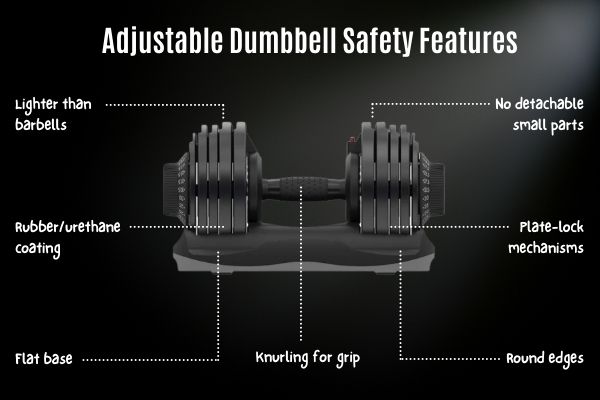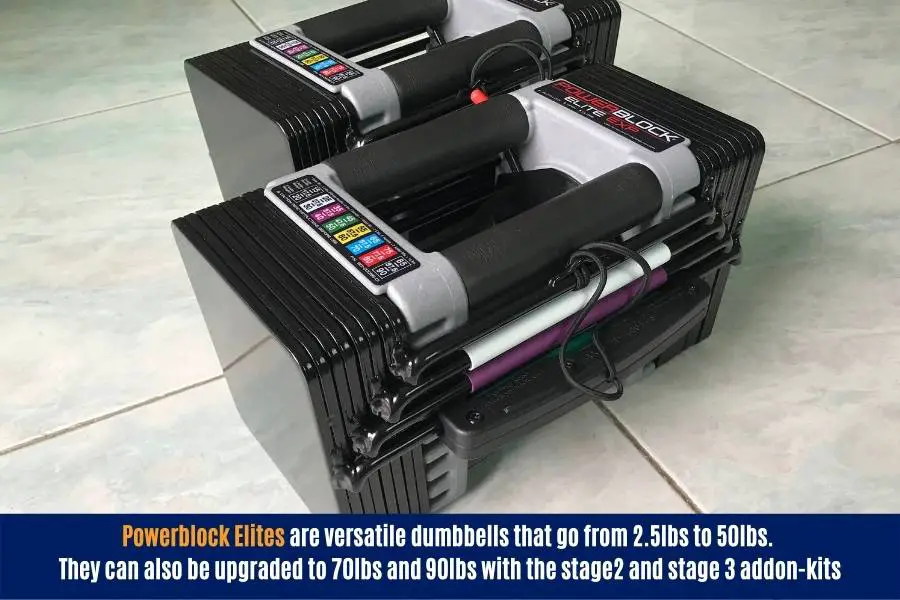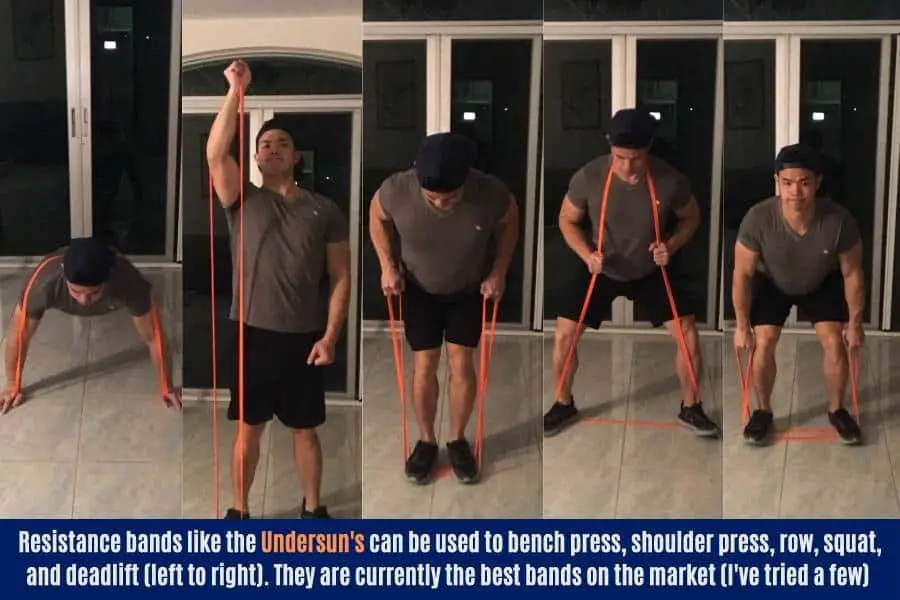The home gym equipment market is huge these days. And amongst the most popular products are adjustable dumbbells. But how safe are they for beginners to use at home? If you don’t want to hurt yourself working out, then you’ll want to keep reading. Because today, I’ll be explaining how safe adjustable dumbbells really are.
In general, adjustable dumbbells are very safe to use. Many are designed with features that minimize the risk of injury to the user. This makes adjustable dumbbells safer than barbells and kettlebells. However, it is recommended to follow good weight lifting practices when training with dumbbells.
I’ve played around with my fair share of free weights during my 10-year weight lifting journey.
I’ve also had my fair share of injuries caused by said free weights.
That’s why I want to share my research and experience with you today!
Let’s go!
Are Adjustable Dumbbells Safe For Home Use?
Adjustable dumbbells are extremely popular and are generally safe for home workouts.

Here are the features that make adjustable dumbbells safe:
- They are lighter than barbells. Adjustable dumbbells are smaller and inherently lighter than barbells, making them safer to use at home.
- Stable flat base prevents rolling. Most adjustable dumbbells have a flattened base and this prevents it from rolling onto your feet or other belongings.
- Often coated in rubber or urethane. An outer synthetic coating not only protects the dumbbells but also minimizes impact damage on your floor and other belongings.
- No sharp edges. Most adjustable dumbbells have rounded edges and this helps prevent injury.
- Handle knurling for optimised grip. Knurling describes the cross-hatching etched into the handle. This increases grip and prevents the adjustable dumbbell from slipping out of your hand. Some dumbbells may have rubber sleeves instead of knurling.
- Standard plate-locking mechanisms. Plate securement mechanisms are standard and prevent the weight plates from sliding off the adjustable dumbbell handle. Some adjustable dumbbell models, such as these MX Select adjustable dumbbells, also feature a double-locking system that secures the plates to both the handle and the adjacent plate.

- No detachable small parts. All components are mostly fixed to the dumbbell itself and this prevents choking hazards. The exception are the Powerblock adjustable dumbbells which have a removable weight-select pin. The pins aren’t exactly small, but they are detachable and could be dangerous when accessed by children.
All in all, adjustable dumbbells are perfectly safe to use in a home environment.
Just make sure you use them as they were intended to be used, and obviously keep them away from children and pets as much as you can!
Find out whether you should buy home dumbbells or gym membership in my other article!
Why They Can Be Not-So-Safe.
Although adjustable dumbbells are generally considered to be safe to use, there are certain dangers you should be aware of.
These dangers are mostly inherent risks for ALL free weights, rather than being specific to adjustable dumbbells.

Here are the reasons why adjustable dumbbells could be unsafe:
- Lifting weights that are too heavy. Adjustable dumbbells are heavy, and stabiliser muscles are engaged to brace a movement. Lifting more weight than your stabilisers can handle will cause your form to break down and this could cause injury.
- Lifting too fast is not recommended. Rapid and uncontrolled movements will break your form. Increasing dumbbell weight too fast will also break your form. Both instances will lead to injury.
- Using body momentum to facilitate lifting. It can be tempting to use body momentum to help you lift heavy adjustable dumbbells. For example, swinging your hips to help you bicep curl. This can be dangerous and should be avoided.
- Going past your natural range of motion. Range of motion refers to how your arms move around the joint. Exceeding your natural range of motion puts stress on the joints and muscles, and this could cause tears.
- Performing bench exercises. Practice is required to set yourself up on bench exercises like the dumbbell bench press (requires you to kick the dumbbells and stabilise them mid-air). Beginners could injure themselves if done improperly.
- Dropping an adjustable dumbbell after a lift. Adjustable dumbbells are sometimes dropped after an exercise due to fatigue (e.g. exiting a failed lift). This could cause injury for inexperienced lifters.
Check out my other article to find out what Kg dumbbells you should buy!
Using Adjustable Dumbbells Safely.
Adjustable dumbbells are perfectly safe when they are used correctly.
Here are the steps you can take to prevent injury when using adjustable dumbbells:

Step 1: warm up and warm down.
A warm-up is essential before any workout, and especially before an intense workout. This will get your circulation going and prepare your muscles for exercise. Each warm-up should consist of 10-15 minutes of static and dynamic stretching.
Warm-up sets are recommended before heavy lifting, but not essential when lifting at moderate weights. That being said, doing warm-up sets is never a bad idea!
Finally, a warm down should be completed after a workout (stretching).
Step 2: lift with good form and technique.
Always lift your adjustable dumbbells with good form.
Good form practices will vary between exercises, and the specifics can be learned on youtube and similar resources.
But as a general rule, you should always lift in a slow and controlled manner.
Lifting tempo describes the speed at which you lift a weight (the up and down movements).
2-0-1 is a good tempo for beginners.
This requires you to count 2 seconds as you lower the weight and 1 second as you lift a weight.
By doing this, you will force your movements to become slower and more controlled, leading to better form!
Step 3: use manageable weight loads.
Never lift a weight you can’t handle.
Adjustable dumbbells have many weight increments, and it can be tempting to lift heavy poundages on heavier adjustable dumbbells.
But you should always make sure you can lift the weight with good form.
In general, beginners should aim for a weight that challenges and fatigues the target muscle for 8-15 reps.
This is a great rep range that strikes a balance between building muscle, increasing strength, and toning muscle.
If your weight doesn’t allow you to successfully complete 8-15 reps, then you should lower the weight (and vice versa).
Once you get comfortable with this rep range, you can begin to increase the weight to keep yourself challenged!
Step 4: progress slowly but steadily.
Progression is key to effective training and can be achieved by increasing workout intensity.
You can increase workout intensity by increasing:
- Weight.
- Reps.
- Sets.
- Training days.
- Decreasing rest time between sets.
- Decreasing lifting tempo.
Regardless of your chosen method, make sure you do it slowly.
This means you shouldn’t jump from a 20lb bicep curl to a 40lb bicep curl in the space of a week!
Instead, add a few pounds every week until you reach your target.
This principle of slow and steady progression applies to any method of increasing intensity.
You can go to my other article to learn when and how to increase dumbbell weight safely.
Do Adjustable Dumbbells Break?
So adjustable dumbbells are safe, but do they break?
Adjustable dumbbells are generally well-built products but they can break. They are made from mostly iron and steel components, giving them a sturdy build. However, just like any product with moving parts, failure can occur if the moving components become damaged.

Here are some of the ways adjustable dumbbells can break:
- Dropping your adjustable dumbbells is not recommended. Many come with “do not drop” labels. This may sound obvious, but this is the most important thing not to do if you want to keep your adjustable dumbbells functioning.
- Plastic components can shatter. Most adjustable dumbbells feature plastic components somewhere in the design. Plastic is commonly found on the dials, cradle, internal weight select mechanism, and the bridge between handle and weight plates. These can shatter on heavy impact. And this can also be unsafe. So be careful!
- Weight-select dials can break. Not only can the external dial casing shatter on impact, but the internal components can also break. I would recommend rotating the dial slowly and avoid being heavy-handed.
- Weight plates can become misaligned. Many adjustable dumbbell weight plates rattle when shaken. And if shaken too vigorously, they MAY become misaligned from the cradle, causing failure. This problem can be exacerbated if you force a misaligned dumbbell back into the cradle.
- Weight plates become loose. Many adjustable dumbbells have internal weight-selector discs made from plastic. These are susceptible to cracking. When this happens, the weight plates may become loose. And this can make lifting adjustable dumbbells not safe to use. This is not an uncommon occurrence with the Bowflex adjustable dumbbells!
Most of these adjustable dumbbell issues can be mitigated if you are careful and look after them properly (check out my guide on how to care for your dumbbells)!

Check out my other article for a guide to buying adjustable dumbbells!
Recommendation For Safe Adjustable Dumbbells
I use and recommend the Powerblock Elites.
Having used multiple dumbbells in the past, these are the ones I decided to settle on.
You can find my hands-on testing of the PowerBlock Elite here.

I found the plate-locking mechanism to be the most secure on the Powerblocks compared to their competitors (especially in comparison to the Bowflex dumbbells).
The shape of the Powerblocks also makes them very stable when laid on the floor (they won’t roll around like round dumbbells).
Additionally, the weight adjustment mechanism feels sturdy and I’ve not had an issue with the weight plates coming undone from the main unit (which has happened to me with the Bowflex dumbbells).
Furthermore, the unit is mostly made from powder-coated heavy-duty steel with minimal plastic components. This makes them extremely durable and they definitely don’t feel like they could break anytime soon!
If you’re from the UK, then the Powerblock Sports are more cost-effective than the Elites since they don’t need to be imported from third-party sellers.
You can go to my comparison post if you can’t decide between the PowerBlock vs Bowflex adjustable dumbbells.
Adjustable Dumbbell Alternatives.
So adjustable dumbbells are safe and don’t often break (if cared for properly).
But some of you may still not yet be convinced about purchasing adjustable dumbbells.
So what can you use instead?
Here are some adjustable dumbbell alternatives you can use to workout at home:
- Spin-lock-dumbbells. These are also adjustable dumbbells but they are much more resilient. A good pair of iron spin-lock dumbbells like the Yes4alls will feature steel handles and cast iron weight plates, making them impervious to damage (beware of cheap plastic models though). Most also feature lower poundages and a more secure locking mechanism, making them safer for beginners.
- Resistance bands. These are an extremely cheap way to do home workouts. They are also much safer than adjustable dumbbells since there are no weight plates. Instead, resistance is generated as the band stretches. They are generally durable, but tears in the material can quickly develop into breakages. The Undersun bands come in a set of 5, each with different resistance levels. They’ve lasted me a few years with no sign of wear and tear. The best thing about them is their lifetime warranty!

- Body weight training. Cheapest and safest way to train! You can also use TRX suspension trainers and gymnastic rings to generate better angles and facilitate body weight exercises at home. These types of exercises are generally safer than adjustable dumbbell exercises and can be just as effective.
- Barbells. Adjustable dumbbells are cheaper and safer than barbells, but barbells are much more hardwearing. You’ll rarely find a barbell breaking!
- Fixed-weight dumbbells. Same as barbells.
These can all be used to safely build muscle, strength, and tone, in the comfort of your own home!
Go to my other article for cheap ways to lift weights at home!
Conclusion
Today I’ve explained how safe adjustable dumbbells actually are.
If used correctly and looked after, adjustable dumbbells are some of the safest free weights you can use at home.
They have various design features which are aimed at minimizing the risk of injury.
But just like any free weight, they can become dangerous if they are abused or used incorrectly. So make sure you follow the steps provided to lift adjustable dumbbells safely.
And if you’re still concerned about the safety of adjustable dumbbells, you can always try the other home resistance training alternatives!
What do you think about using adjustable dumbbells?
Feel free to send me a message if you have any questions! You can find my details on the “contact us” page.
You may also be interested in the downloadable Kalibre Blueprint PDF which details exactly how I gained 40lbs of lean muscle (it’s 100% free!). It details the exact exercises and nutrition (with printable worksheets) I used to go from skinny to ripped!
Thanks for reading guys!
Peace Out,
Kal
(Biochemistry BSc, Biomedical Sciences MSc, Ex-Skinny Guy)


